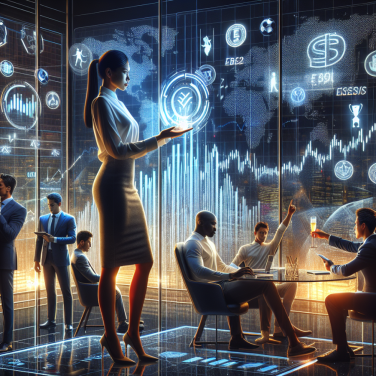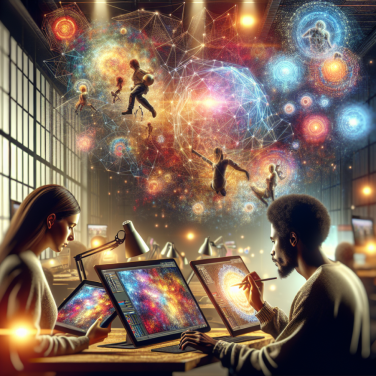Navigating the Nexus of Creativity and Blockchain Technology
In the evolving world of art and technology, the emergence of non-fungible tokens (NFTs) has created a new frontier where creativity intersects with blockchain innovation. This phenomenon is ushering in what some are calling a digital renaissance, affording artists unprecedented control over their work and redefining what it means to own and collect art.
Central to the NFT movement is the concept of digital scarcity. Artists can mint unique, digital tokens that represent ownership of a specific work of art. These tokens are indivisible and cannot be replicated, making them scarce by design. This scarcity mirrors the characteristics of physical pieces of art but comes with the benefits of digital distribution.
Blockchain technology underpins the creation and transfer of NFTs, ensuring the security and authenticity of each artwork. Transactions are recorded on a decentralized ledger that is transparent and immutable, giving buyers confidence that the artwork they purchase is genuine and traceable back to the original creator. This fosters a new level of trust in the digital art market, addressing longstanding issues around replication and distribution that have traditionally plagued digital artists.
Artists-driven NFT ventures are at the forefront of this revolution. By leveraging blockchain, they can retain greater control over their works' distribution, sale, and resale. Smart contracts, which are self-executing contracts with the terms directly written into code, enable artists to automate royalties, ensuring they earn a percentage of sales each time their artwork changes hands on the secondary market. This mechanism represents a sustainable revenue model that supports artists beyond the initial sale, an advantage seldom available in the traditional art market.
Moreover, the NFT space is catalyzing a community-centric approach to art. Many artists are not only selling their work but also engaging with their audience in more meaningful ways. Some offer their NFT holders exclusive access to new works, events, or behind-the-scenes content, cultivating a sense of belonging and patronage akin to the art benefactors of the past.
The creative process itself is being rethought within the context of NFTs. Artists experiment with new mediums and forms, integrating elements such as interactivity, motion, and even augmented reality. This innovation is not limited to the art itself; it extends to the platforms and spaces where NFTs are showcased. Virtual galleries and augmented reality exhibitions are providing immersive experiences that challenge traditional modes of art consumption.
The flourishing NFT landscape is not without its hurdles.
Read also:
Top 5 Crypto Exchanges Backing Sports Ventures
The Impact of NFTs on the Artistic Landscape: Opportunities and Challenges
The advent of NFTs, or non-fungible tokens, has catalyzed a profound transformation within the realm of art, reshaping how artists create, distribute, and monetize their work. This digital innovation is impacting both the creative process and the market dynamics, presenting a unique blend of opportunities and challenges that are worth exploring.
One of the most significant opportunities NFTs present to artists is the ability to assert provenance and authenticity for digital works in ways that were previously impossible. Each NFT is tied to a unique digital asset, which can be anything from an image or a piece of music to an interactive multimedia experience. This uniqueness allows artists to claim ownership and issue a limited number of editions, thus creating scarcity and potential value for digital art, much like traditional physical art.
Furthermore, NFTs unlock direct access to a global audience. Digital marketplaces enable artists to bypass traditional gatekeepers such as galleries and art dealers, fostering a more democratic landscape where artists can directly engage with collectors and fans. This direct-to-consumer model can significantly increase an artist's share of profits and allows for the cultivation of a dedicated following.
NFTs also offer artists the power to incorporate royalties into their digital artworks. Using smart contracts, creators can automatically receive a percentage of sales whenever their art is resold on the secondary market. This creates a sustainable revenue model for artists where they can continue to earn from their creations long after the initial sale.
However, the rise of NFTs is not without its challenges. The high energy consumption associated with blockchain technology and the carbon footprint of minting NFTs have sparked environmental concerns. Artists must navigate an evolving discussion about sustainability and the adoption of more eco-friendly blockchain solutions.
In addition, the NFT market can be volatile with speculative trading sometimes overshadowing the artistic value of the works. This speculation can result in economic bubbles, making the market for digital art uncertain and unstable. Artists entering the space may need to manage their expectations regarding long-term value and income, as well as the potential for sudden shifts in market trends.
Another challenge lies in the inherent complexity of the technology. For those not well-versed in cryptocurrencies, blockchain, and digital wallets, the learning curve can be steep. Artists must therefore educate themselves and their audiences to ensure a smooth transaction process, but this may limit accessibility for some.
Lastly, intellectual property rights in the digital space are complex and still subject to legal gray areas.




